Beyaz Dut
 Recently while hosting guests who came to visit my lovely city of Bursa for a few days I took them to Misi Köyü for a village breakfast (serpme kahvaltı). Afterwards we wandered some of the cute back streets and found ourselves (a bit lost) on a rustic dirt pathway. As we rounded a bend I saw an older woman in traditional village garb squatting near a fire with her back to us. As we passed, she looked up and greeted us so we stopped to make some polite conversation. When I explained that I’m an aşçı (cook/chef) and asked permission to take some pictures, she was delighted. As I snapped some photos, she said she was making molasses from white mulberries and gave me a running commentary of everything I had missed thus far in the process. True to Turkish hospitality, the moment she was done explaining she ducked into her home to make some Turkish coffee for us so we could stay and visit. She gathered 3 white plastic chairs for us as her guests while she sat on the ground at our feet outside. We spent a lovely afternoon with her and I learned so much about white mulberries which spurred me on to study about their history as well.
Recently while hosting guests who came to visit my lovely city of Bursa for a few days I took them to Misi Köyü for a village breakfast (serpme kahvaltı). Afterwards we wandered some of the cute back streets and found ourselves (a bit lost) on a rustic dirt pathway. As we rounded a bend I saw an older woman in traditional village garb squatting near a fire with her back to us. As we passed, she looked up and greeted us so we stopped to make some polite conversation. When I explained that I’m an aşçı (cook/chef) and asked permission to take some pictures, she was delighted. As I snapped some photos, she said she was making molasses from white mulberries and gave me a running commentary of everything I had missed thus far in the process. True to Turkish hospitality, the moment she was done explaining she ducked into her home to make some Turkish coffee for us so we could stay and visit. She gathered 3 white plastic chairs for us as her guests while she sat on the ground at our feet outside. We spent a lovely afternoon with her and I learned so much about white mulberries which spurred me on to study about their history as well.
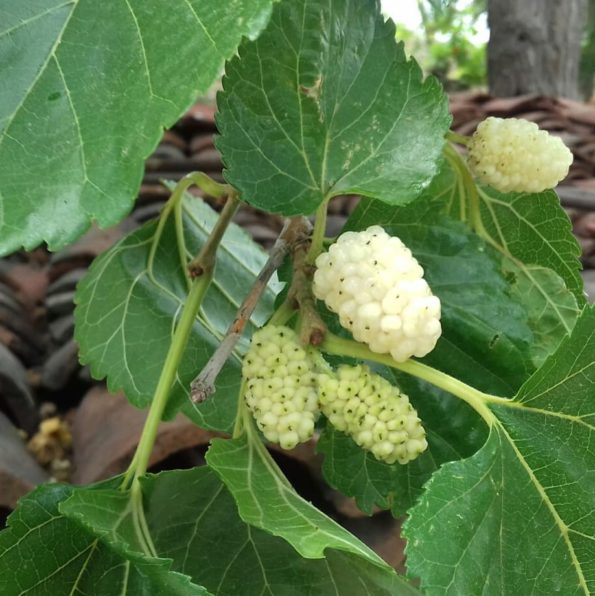 While white mulberries have been valued since Roman times and appear in some early Greek folklore, the white mulberry tree is native to China. Silkworms exclusively eat mulberry leaves and prefer Morus Alba, the white variety. As the Silk Trade Route expanded West, the white mulberry tree was brought West as well. While the two other varieties of mulberries, black (Morus Nigra) and red (Morus Ruba) are common throughout the United States, the white mulberry is very rare and wasn’t introduced at all until colonial times. In 1733, a man imported and planted 500 white mulberry trees in his orchard in Georgia in an attempt to establish the silk industry in the US. Unfortunately, he was largely unsuccessful in his endeavors, but the white mulberry tree,while rare, can still be found throughout North America, even as far as California. Today the largest number of white mulberry trees can be found in Anatolia, Turkey. While the black mulberry is native to Persia (modern-day Iran) it has adapted well to North America and seems to thrive there. The red mulberry is native to eastern & central US.
While white mulberries have been valued since Roman times and appear in some early Greek folklore, the white mulberry tree is native to China. Silkworms exclusively eat mulberry leaves and prefer Morus Alba, the white variety. As the Silk Trade Route expanded West, the white mulberry tree was brought West as well. While the two other varieties of mulberries, black (Morus Nigra) and red (Morus Ruba) are common throughout the United States, the white mulberry is very rare and wasn’t introduced at all until colonial times. In 1733, a man imported and planted 500 white mulberry trees in his orchard in Georgia in an attempt to establish the silk industry in the US. Unfortunately, he was largely unsuccessful in his endeavors, but the white mulberry tree,while rare, can still be found throughout North America, even as far as California. Today the largest number of white mulberry trees can be found in Anatolia, Turkey. While the black mulberry is native to Persia (modern-day Iran) it has adapted well to North America and seems to thrive there. The red mulberry is native to eastern & central US.
 Since mulberry leaves are the only known food source for silkworms, and it seems they prefer leaves from the white mulberry tree, it only stands to reason that Turkey is currently home to most of them in the world. My city of Bursa was actually an important stop near the end of the Silk Trade Route (130 BC to 1453 AD). Silk continues to be an important part of local Turkish culture as evidenced by the famous Turkish silk carpets which are distributed world-wide. Recently I was traveling with my friend to Eastern Turkey to visit Mount Ararat. While there, we toured an amazing carpet store and she purchased this beautiful silk carpet, handmade with local design.
Since mulberry leaves are the only known food source for silkworms, and it seems they prefer leaves from the white mulberry tree, it only stands to reason that Turkey is currently home to most of them in the world. My city of Bursa was actually an important stop near the end of the Silk Trade Route (130 BC to 1453 AD). Silk continues to be an important part of local Turkish culture as evidenced by the famous Turkish silk carpets which are distributed world-wide. Recently I was traveling with my friend to Eastern Turkey to visit Mount Ararat. While there, we toured an amazing carpet store and she purchased this beautiful silk carpet, handmade with local design.
Although the white mulberry tree was brought to Turkey via the Silk Trade Route hundreds of years ago, they continue to flourish today and are an important part of local cuisine. The trees grow fast, about 10 feet per year, until they reach maturity anywhere between 35-60 feet tall. White mulberry trees begin bearing a few fruit in the first year they are planted, though the size and quality of the crop will increase over time. The fruit is harvested in May and June. White mulberries have very low acidity and contain a high concentration of fruity sugar and can be eaten fresh, juiced, or dried for a great source of vitamins, minerals, dietary fiber, and antioxidants; in short, you can never eat too many! Here is a picture of the beautiful mound of dried white mulberries sold at my local Pazar (weekly market) last week among the selection of kuruyemiş (dried fruit and nuts).
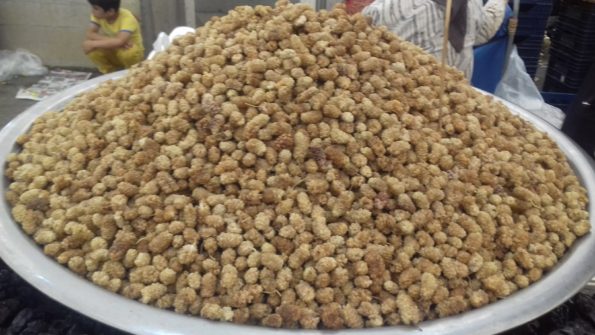 Today we focus on the fruit of white mulberry, but in ancient times the Chinese ground the leaves to powder and used it as traditional medicine to treat diabetes. In fact, today it is known that some chemicals in the white mulberry fruit work similarly to the way the medicine which is used for type 2 diabetes works: they slow the breakdown of sugars in the gut so they are absorbed more slowly into the blood which helps keep blood sugar levels within a desirable range. White mulberries are a super food rich in vitamin C, iron, potassium and magnesium. This delicious fruit is also believed to prevent heart disease as it can be used as an anticoagulant and often called a “blood tonic.” It is also believed that this fruit can cure the common cold, treat anemia, and protect the liver and gallbladder against disease.
Today we focus on the fruit of white mulberry, but in ancient times the Chinese ground the leaves to powder and used it as traditional medicine to treat diabetes. In fact, today it is known that some chemicals in the white mulberry fruit work similarly to the way the medicine which is used for type 2 diabetes works: they slow the breakdown of sugars in the gut so they are absorbed more slowly into the blood which helps keep blood sugar levels within a desirable range. White mulberries are a super food rich in vitamin C, iron, potassium and magnesium. This delicious fruit is also believed to prevent heart disease as it can be used as an anticoagulant and often called a “blood tonic.” It is also believed that this fruit can cure the common cold, treat anemia, and protect the liver and gallbladder against disease.
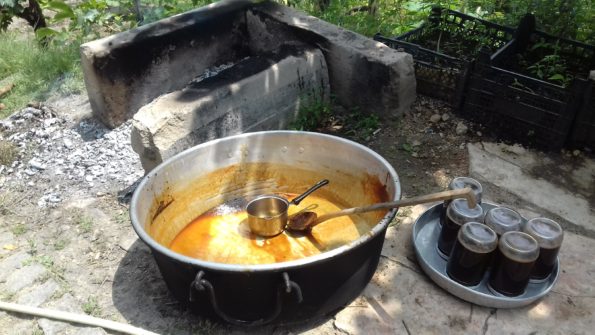 White mulberries are far sweeter than the black and red varieties. This natural sweetness means no need to add sugar and this syrupy sweet fruit is perfect for jams, pies, and molasses. In fact, before sugar was commonly available, traditional molasses called pekmez was often used as a sweet substitute. Pekmez is a very important part of Turkish breakfast. Often this rich molasses is mixed with sesame paste, tahini, and slathered on thick pieces of fresh, crusty bread to kick start the day and provide energy for the whole day ahead. This sweet and nutty combination is best likened to the American peanut butter and honey combination. Pekmez can be made from a variety of fruit, but the most common is grapes, or in the case of today’s article: white mulberries. This special pekmez is known as the “healing syrup of Anatolia” because it is so rich in vitamins. It’s common even today, to hear Turkish mothers encouraging their daughters after giving birth to eat some white mulberry pekmez as it helps to restore blood and energy levels as well as treating postpartum symptoms.
White mulberries are far sweeter than the black and red varieties. This natural sweetness means no need to add sugar and this syrupy sweet fruit is perfect for jams, pies, and molasses. In fact, before sugar was commonly available, traditional molasses called pekmez was often used as a sweet substitute. Pekmez is a very important part of Turkish breakfast. Often this rich molasses is mixed with sesame paste, tahini, and slathered on thick pieces of fresh, crusty bread to kick start the day and provide energy for the whole day ahead. This sweet and nutty combination is best likened to the American peanut butter and honey combination. Pekmez can be made from a variety of fruit, but the most common is grapes, or in the case of today’s article: white mulberries. This special pekmez is known as the “healing syrup of Anatolia” because it is so rich in vitamins. It’s common even today, to hear Turkish mothers encouraging their daughters after giving birth to eat some white mulberry pekmez as it helps to restore blood and energy levels as well as treating postpartum symptoms.
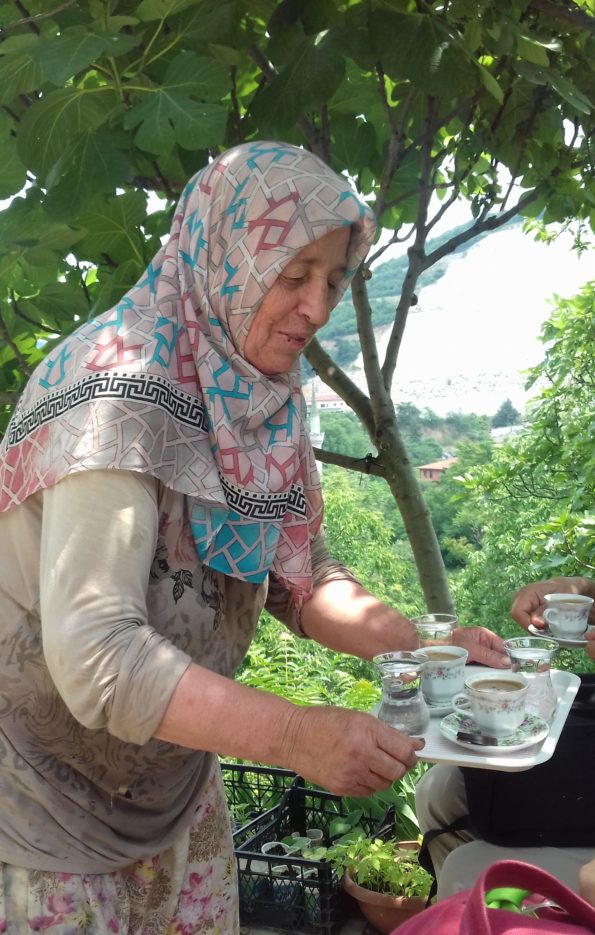 As we sipped Turkish coffee the dear village woman proudly showed me several white mulberry trees growing along the path and towering over her humble home. She explained that to harvest them she places large netted tarps beneath the trees (just like we did for olive harvesting). Her husband climbs the trees and shakes the branches so the soft fruit falls to the tarp. She then collects all of the fruit and picks through it to remove any leaves, dirt or overripe fruit. Then she uses her hands to begin crushing the fruit before placing it in a large pot over a wood fire where she brings it to a boil for a long time. She then carefully pours the hot mixture into a bag of cheese cloth (like a pillowcase). The larger fruit pieces remain inside the cloth but the hot juice seeps through the course fabric and fills her massive pan below. This draining process takes several hours so she said she just hung it up to drain overnight and the following morning she squeezed the cloth to get out as much of the delicious juice as possible. She again pours this into the large pot over the fire and brings it to boil. She slowly stirs the juice and watches as it thickens and is reduced to about 1/3 its volume and has reached a honey-like consistency. Then she carefully ladles the hot syrup into jars, screws on the lids and places them upside down to ensure they seal. She will then have freshly made and entirely healthy sweet molasses for her entire family all year long. And of course, she quickly grabbed a still hot jar and handed it to me as a gift.
As we sipped Turkish coffee the dear village woman proudly showed me several white mulberry trees growing along the path and towering over her humble home. She explained that to harvest them she places large netted tarps beneath the trees (just like we did for olive harvesting). Her husband climbs the trees and shakes the branches so the soft fruit falls to the tarp. She then collects all of the fruit and picks through it to remove any leaves, dirt or overripe fruit. Then she uses her hands to begin crushing the fruit before placing it in a large pot over a wood fire where she brings it to a boil for a long time. She then carefully pours the hot mixture into a bag of cheese cloth (like a pillowcase). The larger fruit pieces remain inside the cloth but the hot juice seeps through the course fabric and fills her massive pan below. This draining process takes several hours so she said she just hung it up to drain overnight and the following morning she squeezed the cloth to get out as much of the delicious juice as possible. She again pours this into the large pot over the fire and brings it to boil. She slowly stirs the juice and watches as it thickens and is reduced to about 1/3 its volume and has reached a honey-like consistency. Then she carefully ladles the hot syrup into jars, screws on the lids and places them upside down to ensure they seal. She will then have freshly made and entirely healthy sweet molasses for her entire family all year long. And of course, she quickly grabbed a still hot jar and handed it to me as a gift.
Before we parted, with phone numbers exchanged and promises to meet again, we posed for this picture together
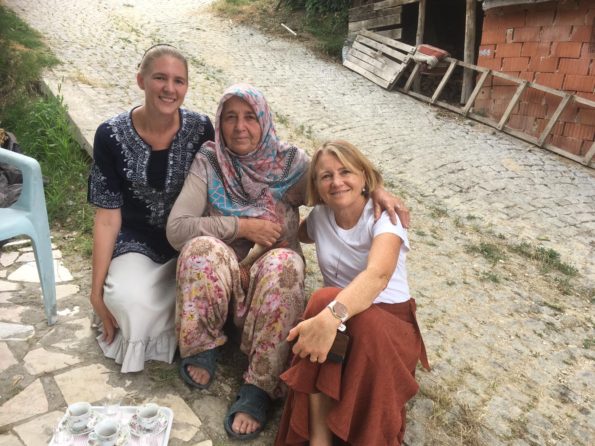
Her humble home to the left of the path and her cooking fire and fresh molasses to the right
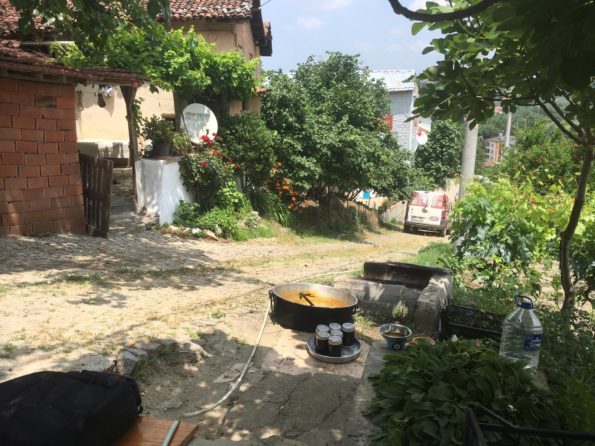
The plastic crate which held the fresh mulberries, large pan which collected the juice and the lines where she hung the bag of cooked berries to drain all night long
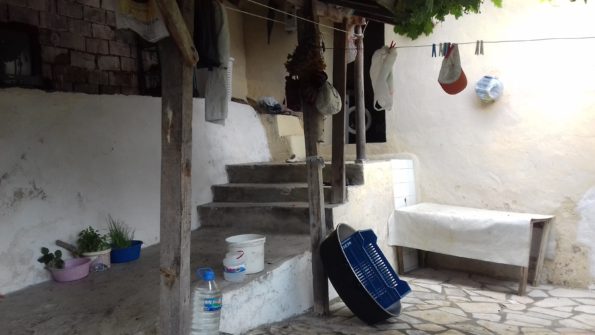
The finished jars of pekmez (molasses) in jars and upside down to seal. Yum!
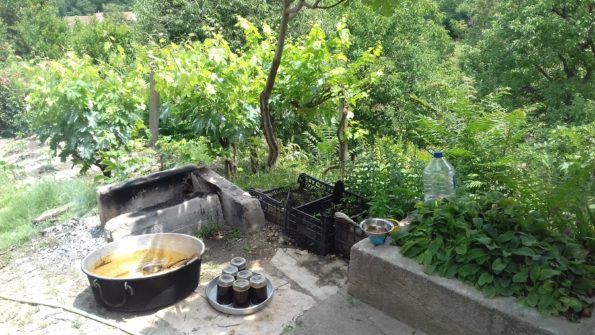
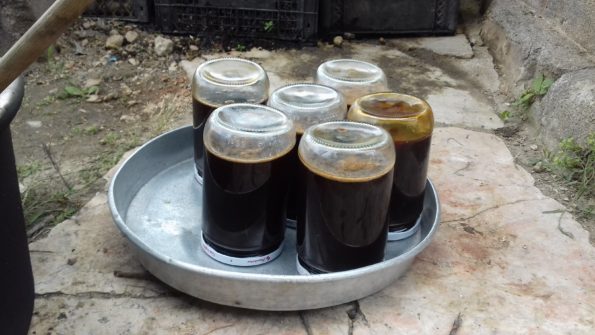



Julene
Wow. This is so fascinatig! I had no idea white mulberries were such a good food to eat! I love reading your stories because I learn alot but in a very interesting way!
Josh
Great post! Only thing you missed is how horrible it is to park your car under these trees!
Jale
Very true. They also make a very slippery, sticky mess on the sidewalks which makes being a pedestrian hazardous as well.
Sylvia Helser
I enjoyed learning about Turkish “molasses.” What a powerhouse of taste and nutrition! And Jale, it was wonderful to meet you in Geneva, Illinois, USA, last week. Your work of learning and sharing Turkish cuisine with us is really appreciated. I am making a collection of your authentic recipes, and was delighted to see your cookbook and many Turkish items on display. Thank you.
Courtney Platt
A superbly written, very informative and interesting article on the white mulberry history and use in Turkey. I spent a month in SW Turkey in 2000 and again in 2001, eating dried kuru duts (mulberries) daily. They cost about $8 USD per kilo if I recall correctly, so I’d get a kilo every week and shared with my colleagues. I was so impressed that I’ve pined for them ever since and am looking for a source of the dried fruit or to plant some trees if the white mulberry can survive in the Caribbean. Nobody that I know has one in Cayman and I’d love to be the first.
GEORGE H.
YOU CAN BUY TWO 1 LBS BAGS OF DRIED ORGANIC WHITE MULBERRIES FROM TURKEY FROM TERRASOUL ON AMAZON $13.95 DELICIOUS!!
Shahnaz
What is the price for one kg white mulberry mulasses in Turkey?
Jale
It depends on where you buy it. For example from a village or local pazar. But at a normal grocery store in Istanbul you can easily buy dut pekmezi for under 10 TL a jar (380 grams).
Ceyhun
Merhaba.
Çalışmalarınız harika. Sizi tebrik ediyorum. Bizde dut pekmezinden yapılan, pestil tatlısı imal ediyoruz. Sizi misafir etmek ve bu ürünü anlatmak isteriz.
http://www.uctatgida.com.tr
+905336048589